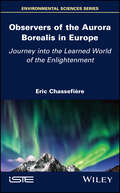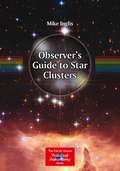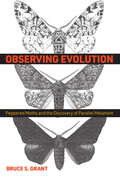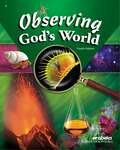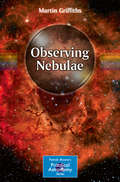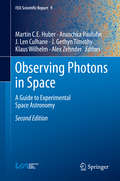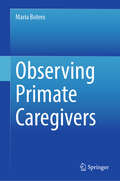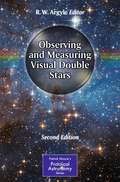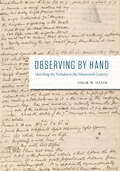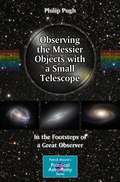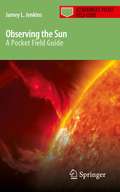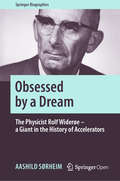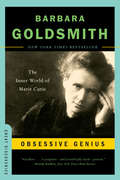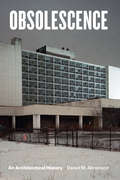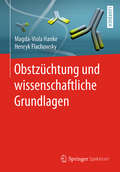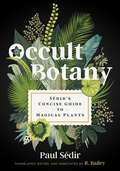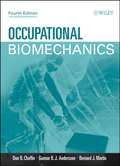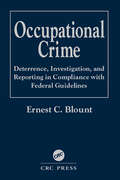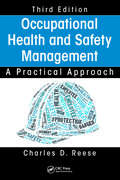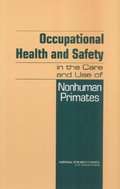- Table View
- List View
Observers of the Aurora Borealis in Europe: Journey into the Learned World of the Enlightenment
by Eric ChassefiereThe spectacular reappearance of the aurora borealis at the beginning of the 18th century, often observed simultaneously from different observatories in Europe, mobilized and federated a large community of astronomers on a European scale. It encouraged them to communicate the results of their observations and, in compiling exhaustive catalogs of information, has helped to establish a system of the aurora borealis that can be further studied in the future, according to the experimental method inherited from the previous century. This book is dedicated to some of the main aurora observers in Europe and to the human, institutional and philosophical context in which they evolved in the first half of the 18th century. Its reading should be seen as a retrospective journey through the scholarly world of the Enlightenment, during which the same scholars are frequently encountered and reencountered, yet each time in different contexts, or from different angles, with the aim of compiling an account of the swarming of ideas and encounters that constituted the development of experimental science in this pivotal period.
Observer’s Guide to Star Clusters
by Mike InglisAmateur astronomers of all expertise from beginner to experienced will find this a thorough star cluster atlas perfect for easy use at the telescope or through binoculars. It enables practical observers to locate the approximate positions of objects in the sky, organized by constellation. This book was specifically designed as an atlas and written for easy use in field conditions. The maps are in black-and-white so that they can be read by the light of a red LED observer's reading light. The clusters and their names/numbers are printed in bold black, against a "grayed-out" background of stars and constellation figures. To be used as a self-contained reference, the book provides the reader with detailed and up-to-date coverage of objects visible with small-, medium-, and large-aperture telescopes, and is equally useful for simple and computer-controlled telescopes. In practice, GO-TO telescopes can usually locate clusters accurately enough to be seen in a low-magnification eyepiece, but this of course first requires that the observer knows what is visible in the sky at a given time and from a given location, so as to input a locatable object. This is where "The Observer's Guide to Star Clusters" steps in as an essential aid to finding star clusters to observe and an essential piece of equipment for all amateur astronomers.
Observing Evolution: Peppered Moths and the Discovery of Parallel Melanism
by Bruce S. GrantA firsthand account of how a modest moth demonstrated Darwin's theory of natural selection.The extraordinary tale of the humble peppered moth is at the very foundation of our acceptance of Darwinian evolution. When scientists in the early twentieth century discovered that a British population of the small, speckled Biston betularia had become black over the course of mere decades in response to the Industrial Revolution's encroaching soot, the revelation cemented Darwin's theory of natural selection. This finding was the staple example of "evolution in action" until the turn of the millennium, when proponents of Creationism fomented doubts about the legitimacy of early experiments. In the midst of this upheaval, evolutionary biologist Bruce S. Grant and his contemporaries were determinedly building a dataset that would ultimately vindicate the theory of industrial melanism in the peppered moth and, by extension, the theory of natural selection itself. Observing Evolution tells the remarkable story of this work. Shining a light on the efforts of scientists who tested Darwin's trailblazing theory, Grant chronicles the historical foundations of peppered moth research, then explains how he and his collaborators were able to push this famous study forward. He describes how his experiments were designed and conducted while painting a vivid picture of the personalities, events, and adventures around the world that shaped his successes—and struggles. His story culminates with his discovery of the mirrored "rise and fall" of melanism in peppered moth populations separated by the vastness of the Atlantic Ocean, which settled the intense controversy around evolution by documenting nature's recurring experiment. Observing Evolution is a crash course in natural selection and the history of evolutionary biology for anyone interested in Darwin's legacy. It's also a fascinating read for lepidopterists and scientists about the bridge between classic experiments and today's sophisticated DNA sequencing, which reveals in ever greater detail how the lives of these tiny organisms have such enormous implications.
Observing God's World
by Abeka BooksObserving God's World, is a Science by Abeka, for homeschooling, or schools to use for 6th grade studies.
Observing God's World (4th Ed.)
by Gregory Rickard Gregory ParkerA textbook designed to train children and young people in the Christian way of life.
Observing Nebulae
by Martin GriffithsThis book enables anyone with suitable instruments to undertake an examination of nebulae and see or photograph them in detail. Nebulae, ethereal clouds of gas and dust, are among the most beautiful objects to view in the night sky. These star-forming regions are a common target for observers and photographers. Griffiths describes many of the brightest and best nebulae and includes some challenges for the more experienced observer. Readers learn the many interesting astrophysical properties of these clouds, which are an important subject of study in astronomy and astrobiology. Non-mathematical in approach, the text is easily accessible to anyone with an interest in the subject. A special feature is the inclusion of an observational guide to 70 objects personally observed or imaged by the author. The guide also includes photographs of each object for ease of identification along with their celestial coordinates, magnitudes and other pertinent information. Observing Nebulae provides a ready resource to allow anyone with a little experience in astronomy, whether professional or amateur, to locate, identify and record the nebulae in our home galaxy. The author enables the observer to use a telescope and filters to the best advantage to see these celestial wonders, or to couple filters to a CCD camera or digital SLR camera in order to take quality images of celestial objects. By using these techniques it is even possible to make a valid contribution to professional investigations. And the views are unbeatable.
Observing Photons in Space
by Martin C. E. Huber Anuschka Pauluhn J. Len Culhane J. Gethyn Timothy Klaus Wilhelm Alex ZehnderAn ideal resource for lecturers, this book provides a comprehensive review of experimental space astronomy. The number of astronomers whose knowledge and interest is concentrated on interpreting observations has grown substantially in the past decades; yet, the number of scientists who are familiar with and capable of dealing with instrumentation has dwindled. All of the authors of this work are leading and experienced experts and practitioners who have designed, built, tested, calibrated, launched and operated advanced observing equipment for space astronomy. This book also contains concise information on the history of the field, supported by appropriate references. Moreover, scientists working in other fields will be able to get a quick overview of the salient issues of observing photons in any one of the various energy, wavelength and frequency ranges accessible in space. This book was written with the intention to make it accessible to advanced undergraduate and graduate students.
Observing Primate Caregivers
by Maria BoteroThis book aims to advance our understanding of the caregiver-infant interaction in primates and its effect on the development of social cognition, working from an interdisciplinary approach (i.e., psychology, philosophy, and anthropology), challenging the dominant cognitivist perspectives and methodologies. This book is important because it contributes to understanding how primate parent-and-infant interaction works and how it affects the infant’s development. Understanding this parent-and-infant interaction contributes to finding better ways to support human parents and provide better care for non-human primate mothers and infants in captivity.
Observing Projects Using Starry Night College
by Marcel W. Bergman T. Alan Clark William J. F. WilsonAstronomy is an observational science. The opportunity to make meaningful observations of the real sky is very important in the study of astronomy. Unfortunately, many students of introductory astronomy are denied this opportunity because of light pollution or the lack of adequate equipment or resources. The projects described in this book provide an effective substitute for this observing experience by allowing these students to make significant and accurate observations of the virtual sky using the Starry NightTM program. It is hoped that these projects will also enhance the experience of students blessed with the resources to make real ground-based observations.
Observing and Measuring Visual Double Stars
by R. W. ArgyleThe second edition of Observing and Measuring Visual Double Stars (2004) is the definitive book for those who are serious about this fascinating aspect of astronomy. It deals with equipment (you can start modestly with commercial or even home-made instruments), observing methods using binoculars upwards to advanced instrumentation and techniques, including speckle interferometry. The astronomy of double stars, including orbital calculation, is given its own section. This second edition of this popular book contains a significant amount of completely new material, inspired by the work done by observers - particularly in the USA - since the first edition was published. This includes the use of the Internet to carry out astrometry (precise astronomical measurement) using existing survey plates and films. The new edition contains an excellent guide to sketching double stars, a topic not previously covered. In addition, there is information about how to image double stars of unequal brightness, always a difficult matter but now somewhat easier because of advances in hardware and image-processing software. Nearly all of the chapters and tables have been updated. The CD-ROM that accompanied the first edition of Observing and Measuring Visual Double Stars is replaced by access to the Springer Extras web site. The extra information includes the complete Washington Double Star and Tycho-2 Catalogs. There is an extensive database of astrometric, double-and multiple-star formation, including positions, orbits, separations, and magnitudes, and a software suite that implements many of the calculations and equations featured in the book.
Observing by Hand: Sketching the Nebulae in the Nineteenth Century
by Omar W. NasimToday we are all familiar with the iconic pictures of the nebulae produced by the Hubble Space TelescopeOCOs digital cameras. But there was a time, before the successful application of photography to the heavens, in which scientists had to rely on handmade drawings of these mysterious phenomena. aaaaaaaaaaa"Observing by Hand" sheds entirely new light on the ways in which the production and reception of handdrawn images of the nebulae in the nineteenth century contributed to astronomical observation. Omar W. Nasim investigates hundreds of unpublished observing books and paper records from six nineteenth-century observers of the nebulae: Sir John Herschel; William Parsons, the third Earl of Rosse; William Lassell; Ebenezer Porter Mason; Ernst Wilhelm Leberecht Tempel; and George Phillips Bond. Nasim focuses on the ways in which these observers created and employed their drawings in data-driven procedures, from their choices of artistic materials and techniques to their practices and scientific observation. He examines the ways in which the act of drawing complemented the acts of seeing and knowing, as well as the ways that making pictures was connected to the production of scientific knowledge. aaaaaaaaaaaAn impeccably researched, carefully crafted, and beautifully illustrated piece of historical work, "Observing by Hand "will delight historians of science, art, and the book, as well as astronomers and philosophers. "
Observing the Messier Objects with a Small Telescope
by Philip PughObserving the Messier Objects with a Small Telescope contains descriptions and photographs of the 103 Messier objects, with instructions on how to find them without a computerized telescope or even setting circles. The photographs show how the objects appear through a 127mm Maksutov (and other instruments, where applicable). The visual appearance of a Messier object is often very different from what can be imaged with the same telescope, and a special feature of this book is that it shows what you can see with a small telescope. It will also contain binocular descriptions of some objects. Messier published the final version of his catalog in 1781 (it contains 103 different objects), a catalog so good that it is still in common use today, well over two centuries later. In making a catalog of all the 'fixed' deep-sky objects that observers might confuse with comets, Messier had succeeded in listing all the major interesting deep-sky objects that today are targets for amateur astronomers. Messier's telescope (thought to be a 4-inch) was, by today's amateur standards, small. It also had rather poor optics by modern standards. Thus - and despite the fact that he was a master observer - all the things Messier saw can be found and observed by any observer using a commercial 127 mm (5-inch) telescope. Observing the Messier Objects with a Small Telescope lets the reader follow in Messier's footsteps by observing the Messier objects more or less as the great man saw them himself!
Observing the Solar System
by Gerald NorthWritten by a well-known and experienced amateur astronomer, this is a practical primer for all aspiring observers of the planets and other Solar System objects. Whether you are a beginner or more advanced astronomer, you will find all you need in this book to help develop your knowledge and skills and move on to the next level of observing. This up-to-date, self-contained guide provides a detailed and wide-ranging background to Solar System astronomy, along with extensive practical advice and resources. Topics covered include: traditional visual observing techniques using telescopes and ancillary equipment; how to go about imaging astronomical bodies; how to conduct measurements and research of scientifically useful quality; the latest observing and imaging techniques. Whether your interests lie in observing aurorae, meteors, the Sun, the Moon, asteroids, comets, or any of the major planets, you will find all you need here to help you get started.
Observing the Sun: A Pocket Field Guide
by Jamey L. Jenkins"Observing the Sun" is for amateur astronomers at all three levels: beginning, intermediate, and advanced. The beginning observer is often trying to find a niche or define a specific interest in his hobby, and the content of this book will spark that interest in solar observing because of the focus on the dynamics of the Sun. Intermediate and advanced observers will find the book invaluable in identifying features (through photos, charts, diagrams) in a logical, orderly fashion and then guiding the observer to interpret the observations. Because the Sun is a dynamic celestial body in constant flux, astronomers rarely know for certain what awaits them at the eyepiece. All features of the Sun are transient and sometimes rather fleeting. Given the number of features and the complex life cycles of some, it can be a challenging hobby. "Observing the Sun" provides essential illustrations, charts, and diagrams that depict the forms and life cycles of the numerous features visible on the Sun.
Obsessed by a Dream: The Physicist Rolf Widerøe – a Giant in the History of Accelerators (Springer Biographies)
by Aashild SørheimThis Open Access biography chronicles the life and achievements of the Norwegian engineer and physicist Rolf Widerøe. Readers who meet him in the pages of this book will wonder why he isn't better known. The first of Widerøe's many pioneering contributions in the field of accelerator physics was the betatron, the second, the linear accelerator, both summarized in a 27 page PhD. The betatron revolutionized the fields of cancer treatment through radiation therapy and also nondestructive testing; hospitals worldwide installed Widerøe's machine and today’s modern radiation treatment equipment is based on his inventions. The most recent renaissance of the linac provides unprecedented x-ray intensities at Free Electron Laser (FEL) facilities in operation and construction worldwide. . Widerøe’s story also includes a fair share of drama, particularly during World War II when both Germans and the Allies vied for his collaboration. Widerøe held leading positions in multinational industry groups and was one of the consultants for building the world's largest nuclear laboratory, CERN, in Switzerland. He gained over 200 patents, received several honorary doctorates and a number of international awards.The author, a professional writer and maker of TV documentaries, has gained access to hitherto restricted archives in several countries, which provided a wealth of new material and insights, in particular in relation to the war years. She tells here a gripping and illuminating story.
Obsessive Genius: The Inner World of Marie Curie (Great Discoveries)
by Barbara GoldsmithThrough family interviews, diaries, letters, and workbooks that had been sealed for over sixty years, Barbara Goldsmith reveals the Marie Curie behind the myth--an all-too-human woman struggling to balance a spectacular scientific career, a demanding family, the prejudice of society, and her own passionate nature. Obsessive Genius is a dazzling portrait of Curie, her amazing scientific success, and the price she paid for fame. The best-selling, "excellent . . . poignant--and scientifically lucid-- portrait" (New York Times Book Review) of the remarkable Marie Curie.... "Never a dull moment. . . . Goldsmith leads the reader through a wonderland of facts with just the right blend of science and story. In the end, the mystery of the great Madame [Curie] remains, but a deeper understanding of what she went through as a woman and a scientist shines as strong as her radium."--San Francisco Chronicle "Bestselling historian Goldsmith incisively chronicles [Curie's] intensely dramatic life. . . . Her powerful portrait reveals a woman of great passion, genius, and pain who changed the world."--Booklist, starred review
Obsolescence: An Architectural History
by Daniel M. AbramsonIn our architectural pursuits, we often seem to be in search of something newer, grander, or more efficient—and this phenomenon is not novel. In the spring of 1910 hundreds of workers labored day and night to demolish the Gillender Building in New York, once the loftiest office tower in the world, in order to make way for a taller skyscraper. The New York Times puzzled over those who would sacrifice the thirteen-year-old structure, “as ruthlessly as though it were some ancient shack.” In New York alone, the Gillender joined the original Grand Central Terminal, the Plaza Hotel, the Western Union Building, and the Tower Building on the list of just one generation’s razed metropolitan monuments. In the innovative and wide-ranging Obsolescence, Daniel M. Abramson investigates this notion of architectural expendability and the logic by which buildings lose their value and utility. The idea that the new necessarily outperforms and makes superfluous the old, Abramson argues, helps people come to terms with modernity and capitalism’s fast-paced change. Obsolescence, then, gives an unsettling experience purpose and meaning. Belief in obsolescence, as Abramson shows, also profoundly affects architectural design. In the 1960s, many architects worldwide accepted the inevitability of obsolescence, experimenting with flexible, modular designs, from open-plan schools, offices, labs, and museums to vast megastructural frames and indeterminate building complexes. Some architects went so far as to embrace obsolescence’s liberating promise to cast aside convention and habit, envisioning expendable short-life buildings that embodied human choice and freedom. Others, we learn, were horrified by the implications of this ephemerality and waste, and their resistance eventually set the stage for our turn to sustainability—the conservation rather than disposal of resources. Abramson’s fascinating tour of our idea of obsolescence culminates in an assessment of recent manifestations of sustainability, from adaptive reuse and historic preservation to postmodernism and green design, which all struggle to comprehend and manage the changes that challenge us on all sides.
Obstzüchtung und wissenschaftliche Grundlagen
by Magda-Viola Hanke Henryk FlachowskyDieses Buch führt zunächst in die biologischen Grundlagen der Obstzüchtung ein. Nach einer Erklärung der Züchtungsmethoden bei Obst werden die Selektionsverfahren, der Aufbau eines Zuchtprogramms sowie Fragen zum Sortenschutz, zum Inverkehrbringen und zur Sortenverwertung erläutert. Es schließt sich ein ausführlicher Teil an, der die einzelnen Obstarten behandelt. Das Buch richtet sich an Studierende, Fachwissenschaftler und im Obst- und Gartenbau tätige Personen.
Occult Botany: Sédir’s Concise Guide to Magical Plants
by Paul Sédir• Includes a dictionary of nearly 300 magical plants with descriptions of each plant&’s scientific name, common names, elemental qualities, ruling planets, and zodiacal signatures, with commentary on medico-magical properties and uses • Explores methods of phytotherapy and plant magic, including the Paracelsian &“transplantation of diseases,&” ritual pacts with trees, the secret ingredients of witches&’ ointments, and the composition of magical philters • Explains the occult secrets of phytogenesis, plant physiology, and plant physiognomy (classification of plants according to the doctrine of signatures) Merging the scientific discipline of botany with ancient, medieval, and Renaissance traditions of occult herbalism, this seminal guide was first published in French in 1902 as a textbook for students of Papus&’s École hermétique and sparked a revival in the study of magical herbalism in early twentieth-century France. Author Paul Sédir, pseudonym of Yvon Le Loup (1871-1926), explains the occult secrets of phytogenesis (the esoteric origin and evolutionary development of the plant kingdom), plant physiology (the occult anatomy of plants), and plant physiognomy (classification of plants according to the doctrine of signatures). Unveiling the mysteries behind planetary and zodiacal attributions, he provides readers with the keys to make their own informed determinations of the astral properties of plants. Moving from theory into practice, Sédir explores various methods of phytotherapy and plant magic, including the Paracelsian &“transplantation of diseases,&” the secret ingredients of witches&’ ointments, and the composition of magical philters. In the third section of the book, Sédir offers a dictionary of magical plants that covers nearly 300 plant species with descriptions of their astral signatures, occult properties, and medico-magical uses. Compiled from an array of rare sources and esoterica, this classic text includes a wealth of additional materials and supplemental charts and diagrams drawn from Sédir&’s occult colleagues, all of whom adopted and expanded upon Sédir&’s pioneering system of plant correspondences.
Occupational Biomechanics
by Gunnar Andersson Don Chaffin Bernard MartinWith critical applications in manufacturing, transportation, defense, security, environmental safety and occupational health, and other industries, the field of occupational biomechanics is more central to industrial design than ever before. This latest edition of the popular and widely adopted Occupational Biomechanics provides the foundations and tools to assemble and evaluate biomechanical processes as they apply to today's changing industries, with emphasis on improving overall work efficiency and preventing work-related injuries. The book expertly weaves engineering and medical information from diverse sources and provides a coherent treatment of the biomechanical principles underlying the well-designed and ergonomically sound workplace.
Occupational Crime: Deterrence, Investigation, and Reporting in Compliance with Federal Guidelines
by Ernest C. BlountDID YOU KNOW? While organizational entities cannot be sent to prison, they can be heavily fined, ordered to make restitution, placed on probation, forced to forfeit property, suffer public and stakeholder recriminations, and can be forced out of business. Avoid these unnecessary repercussions with Occupational Crime: Deterrence, Investigatio
Occupational Health and Safety Management: A Practical Approach, Third Edition
by Charles D. ReeseReflecting changes in the current health and safety landscape, Occupational Health and Safety Management: A Practical Approach, Third Edition includes examples and tools to facilitate development and implementation of a safety and health management approach. This how-to book is not just an information providing text. It shows you how to write a program and identify hazards as well as involve workers and attain their cooperation. It emphasizes the need for better and more effective communication regarding safety and health.See What’s New in the Third Edition: Chapters on workers’ compensation, terrorism, and Lean safety/sustainability Additional coverage of flammable liquids and ventilation, accident reporting, and accident investigation New compliance requirements as well as expanded accident investigation, environmental, and risk analysis guidelines PowerPoint presentation slides for each chapter A complete and practical guide for the development and management of occupational safety and health programs in any industry setting, the book supplies a management blueprint that can be used for occupational safety and health in any organization, from the smallest to the largest, beginning to develop or wanting to improve its safety and health approach. It includes comprehensive guidelines for development of occupational health and safety programs to a variety of industries and is especially useful for start-up companies.The author takes a total management approach to the development of written programs, the identification of hazards, the mitigation of hazards by the use of common safety and health tools, the development of a safe workforce through communications, motivational techniques, involvement, and training. He addresses the tracking and acceptable risk from both safety and health hazards. He also discusses how to work with and within the OSHA compliance approach as well as how to deal with the OSHA regulations, workers’ compensation, terrorism, and Lean safety. As you understand and apply the guidelines in each chapter, you can put your company on the way toward building a successful and effective safety and health effort for its employers and employees.
Occupational Health and Safety in the Care and Use of Nonhuman Primates
by Committee on Occupational Health Safety in the Care Use of Nonhuman PrimatesThe field of occupational health and safety constantly changes, especially as it pertains to biomedical research. New infectious hazards are of particular importance at nonhuman-primate facilities. For example, the discovery that B virus can be transmitted via a splash on a mucous membrane raises new concerns that must be addressed, as does the discovery of the Reston strain of Ebola virus in import quarantine facilities in the U.S. The risk of such infectious hazards is best managed through a flexible and comprehensive Occupational Health and Safety Program (OHSP) that can identify and mitigate potential hazards. Occupational Health and Safety in the Care and Use of Nonhuman Primates is intended as a reference for vivarium managers, veterinarians, researchers, safety professionals, and others who are involved in developing or implementing an OHSP that deals with nonhuman primates. The book lists the important features of an OHSP and provides the tools necessary for informed decision-making in developing an optimal program that meets all particular institutional needs.
